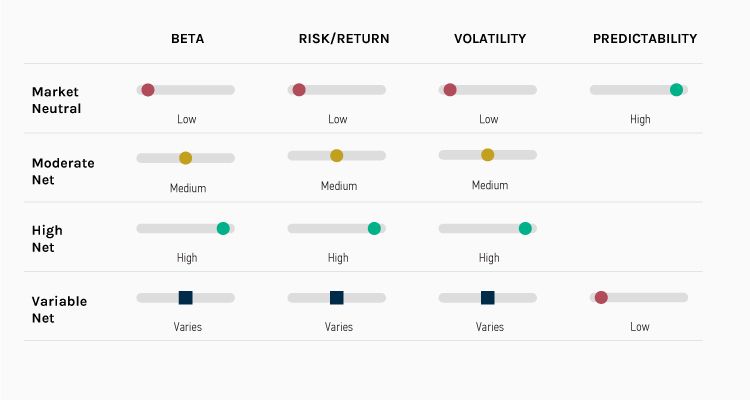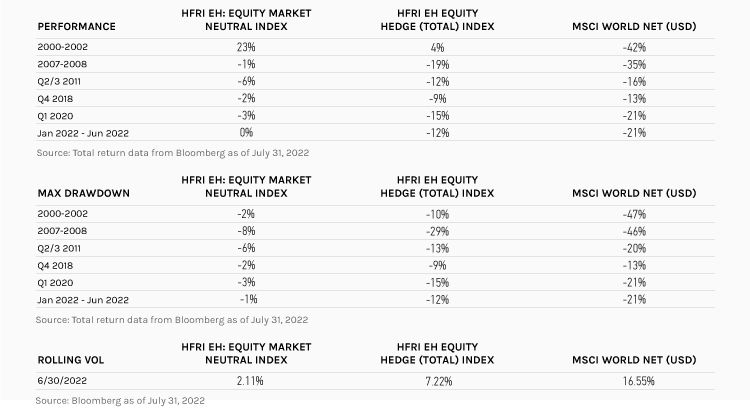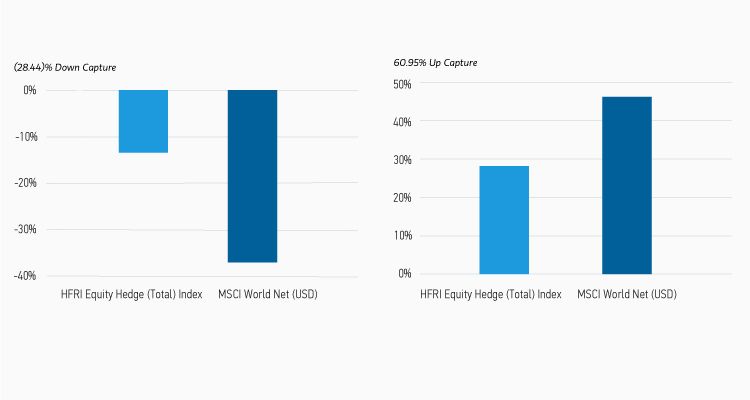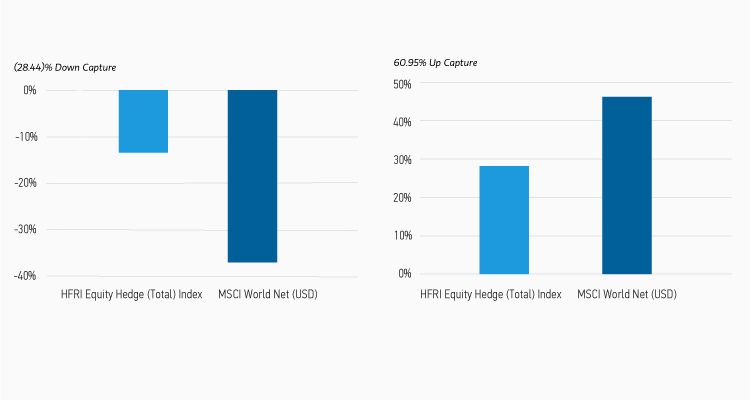
Morgan Stanley IM: Long Short Equity Strategies – "Hedging" Your Bets
Amid the market uncertainty caused by the COVID-19 pandemic, investors may be seeking ways to add resilience to their portfolios. Long-short equity strategies have the potential to deliver steady returns in volatile markets.
10.08.2022 | 07:03 Uhr
Here you can find the complete article
As monetary policy normalizes post-covid and market volatility increases due to inflation and other concerns, investors may be seeking ways to add resiliency to their portfolios. It could therefore be an opportune time to consider the inherently risk-mitigating characteristics of long-short equity strategies.
As the name suggests, long-short equity strategies invest both long and short in publicly traded equities and equity-related instruments. Compared to their long-only counterparts, long-short strategies are designed to have lower sensitivity to equity market movements, as measured by beta, volatility and drawdowns. When included as part of a broadly diversified portfolio, such strategies have the potential to: (1) generate profits from their long and short positions and (2) provide an element of risk mitigation, or hedge, when markets decline because gains on short positions will dampen losses on long positions.
“What is shorting? Short selling involves borrowing shares and selling them at a certain price on the assumption that the price will decline, allowing the seller to buy shares back at a lower price and return them to the owner. Short selling is only profitable when share prices decline and may be exposed to steep losses if share prices rise.”
A Broad Category With A Strategy For Every Risk Appetite
A range of strategies fall under the general category of long-short equity (Display 1). In our view, the most compelling strategy in today’s market environment would be a low-net or zero-net strategy, otherwise known as “market neutral.” Compared to other long-short equity strategies, market neutral strategies tend to exhibit low or zero beta, lower market risk, lower market volatility and seek to generate returns through stock selection. These strategies are not designed to shoot the lights out, but they have the potential to provide steady gains even in down markets.
Display 1: Characteristics of Long-Short Equity Strategies

Long-Short Strategies Are Also Actively Managed
In addition to the potentially risk-mitigating benefits of including short positions, long-short strategies typically have flexibility to adjust their risk profiles in response to changing market conditions. They are not required to maintain static exposures, nor are they tethered to a benchmark. Managers of market-neutral strategies can take a variety of steps to reduce risk and protect capital, specifically:
- Reduce overall portfolio gross exposure by selling longs and covering shorts at the same time, so that the portfolio has less capital at risk
- Reduce position sizes to reduce volatility
- Incorporate portfolio protection in the form of index hedges, futures or options
Long-Short Strategies Have Held Their Own In Prior Market Downturns
During the bear markets of 2000-2002 and 2007-2008, the down markets of mid-2011 and late-2018, the chaotic beginning of 2020 as the COVID-19 pandemic unfolded, and the 2022 bear market, long-short equity strategies broadly, as measured by the HFRI Equity Hedge (Total) Index, and market-neutral strategies more specifically, as measured by the HFRI Equity Market Neutral Index, achieved their goal of mitigating downside risk relative to the broad markets across a variety of metrics (Display 2).
Display 2: Long-Short Equity Performance During Downturns

Among long-short equity strategies, market-neutral strategies have
proven particularly adept at managing downside risk over time, while
allowing investors to participate in up markets as well (Displays 3 and 4).
Display 3: Down and Up Capture Ratios for HFRI EH: Market Neutral Index vs. MSCI World Net (USD) Index

Source: Bloomberg as of July 31, 2022. Annualized return data during negative (down capture) / positive (up capture) months over the period January 1990-June 2022
Display 4: Down and Up Capture Ratios for HFRI Equity Hedge (Total) Index vs. MSCI World Net (USD) Index

Source: Bloomberg as of July 31, 2022. Annualized return data during negative (down capture) / positive (up capture) months over the period January 1990-June 2022
Of course, past performance is no guarantee of future results. Four main risks will always face long-short equity investors:
- MARKET RISK: the risk of loss due to the impact of general market movements.
- IDIOSYNCRATIC RISK: the risk of loss due to company-specific factors that are generally not correlated with the broad market movement.
- SHORT-SALE RISK: the risk that an investment sold short generates significant losses because the stock price appreciates.
- LEVERAGE RISK: the risk of loss due to unexpected interaction between longs and shorts or an improperly hedged portfolio.
Conclusion
These are unprecedented times, and investors are likely looking for ways to increase the resiliency of their portfolios. In our view, including an allocation to market-neutral strategies in a well-balanced portfolio could provide valuable downside risk-mitigating benefits.
Net market exposure: Takes into account the benefits of offsetting long and short positions; is calculated by subtracting the percentage of the fund’s equity capital invested in short sales from the percentage of equity capital used for long positions.
Short interest ratio: A formula that represents the average number of days it takes short sellers to cover their positions, or repurchase the shares they have borrowed. This ratio indicates whether a stock is heavily shorted or not shorted versus its average daily trading volume.
MSCI World Index Net (USD): A market cap weighted stock market index that represents large and mid-cap equity performance across 23 developed markets countries with net dividends reinvested in US dollars.
HFRI EH: Equity Market Neutral Index: Equity Market Neutral strategies employ sophisticated quantitative techniques of analyzing price data to ascertain information about future price movement and relationships between securities, select securities for purchase and sale. These can include both Factor-based and Statistical Arbitrage/Trading strategies. Factor-based investment strategies include strategies in which the investment thesis is predicated on the systematic analysis of common relationships between securities. In many but not all cases, portfolios are constructed to be neutral to one or multiple variables, such as broader equity markets in dollar or beta terms, and leverage is frequently employed to enhance the return profile of the positions identified. Statistical Arbitrage/Trading strategies consist of strategies in which the investment thesis is predicated on exploiting pricing anomalies which may occur as a function of expected mean reversion inherent in security prices; high frequency techniques may be employed and trading strategies may also be employed on the basis on technical analysis or opportunistically to exploit new information the investment manager believes has not been fully, completely or accurately discounted into current security prices. Equity Market Neutral Strategies typically maintain characteristic net equity market exposure no greater than 10% long or short.
HFRI Equity Hedge (Total) Index: Investment Managers who maintain positions both long and short in primarily equity and equity derivative securities. A wide variety of investment processes can be employed to arrive at an investment decision, including both quantitative and fundamental techniques; strategies can be broadly diversified or narrowly focused on specific sectors and can range broadly in terms of levels of net exposure, leverage employed, holding period, concentrations of market capitalizations and valuation ranges of typical portfolios. EH managers would typically maintain at least 50% exposure to, and may in some cases be entirely invested in, equities, both long and short.
DISCLAIMERS
The views and opinions are solely those of the author as of the date of publication, are subject to change at any time due to market or economic conditions, will not be updated or supplemented after the date hereof and may not necessarily come to pass. The views and opinions expressed herein do not reflect those of all investment personnel at Morgan Stanley Investment Management (MSIM) or the views of the firm as a whole, and may not be reflected in all the strategies and products that the firm offers.
Certain statements herein are based upon the views and opinions of or data obtained from one or more third parties. While MSIM believes these statements to be an accurate summary of such views, opinions and/or data, MSIM has not independently verified their accuracy or completeness, or of any factual statements or other information forming the basis of or contained in any such views, opinions and/or data, and accordingly MSIM makes no representation or warranty, express or implied, with respect thereto. MSIM and its affiliates disclaim any and all liability arising from or in connection with any use of or reliance upon any such views, opinions, data, statements or other information.
All content herein is protected under copyright and other applicable laws, and may not be distributed or republished without the prior written authorization of MSIM.
This general communication, which is not impartial, is for informational and educational purposes only and not a recommendation, solicitation, offer or solicitation of an offer to buy or sell any securities or otherwise engage in any investment strategies. The information herein does not address financial objectives, situation or specific needs of individual investors.
Any charts and graphs provided are for illustrative purposes only. Any performance quoted represents past performance. Past performance does not guarantee future results. All investments involve risks, including the possible loss of principal.
Global Pandemics. Portfolios are subject to market risk, which is the possibility that the market values of securities owned by the portfolio will decline and that the value of portfolio shares may therefore be less than what you paid for them. Market values can change daily due to economic and other events (such as natural disasters, epidemics and pandemics, terrorism, conflicts and social unrest) that affect markets generally, as well as those that affect particular regions, countries, industries, companies or governments. It is difficult to predict when events may occur, the effects they may have (e.g. adversely affect the liquidity of the portfolio), and the duration of those effects.
DISTRIBUTION
This communication is only intended for and will only be distributed to persons resident in jurisdictions where such distribution or availability would not be contrary to local laws or regulations.
United Kingdom: Morgan Stanley Investment Management Limited is authorised and regulated by the Financial Conduct Authority. Registered in England. Registered No. 1981121. Registered Office: 25 Cabot Square, Canary Wharf, London E14 4QA, authorised and regulated by the Financial Conduct Authority. Dubai: Morgan Stanley Investment Management Limited (Representative Office, Unit Precinct 3-7th Floor-Unit 701 and 702, Level 7, Gate Precinct Building 3, Dubai International Financial Centre, Dubai, 506501, United Arab Emirates. Telephone: +97 (0)14 709 7158). Germany: Morgan Stanley Investment Management Limited Niederlassung Deutschland Junghofstrasse 13-15 60311 Frankfurt Deutschland (Gattung: Zweigniederlassung (FDI) gem. § 53b KWG). Ireland: Morgan Stanley Investment Management (Ireland) Limited. Registered Office: The Observatory, 7-11 Sir John Rogerson’s, Quay, Dublin 2, Ireland. Registered in Ireland under company number 616662. Authorised and regulated by Central Bank of Ireland. Italy: Morgan Stanley Investment Management Limited, Milan Branch (Sede Secondaria di Milano) is a branch of Morgan Stanley Investment Management Limited, a company registered in the U.K., authorised and regulated by the Financial Conduct Authority (FCA), and whose registered office is at 25 Cabot Square, Canary Wharf, London, E14 4QA. Morgan Stanley Investment Management Limited Milan Branch (Sede Secondaria di Milano) with seat in Palazzo Serbelloni Corso Venezia, 16 20121 Milano, Italy, is registered in Italy with company number and VAT number 08829360968. The Netherlands: Morgan Stanley Investment Management, Rembrandt Tower, 11th Floor Amstelplein 1 1096HA, Netherlands. Telephone: 31 2-0462-1300. Morgan Stanley Investment Management is a branch office of Morgan Stanley Investment Management Limited. Morgan Stanley Investment Management Limited is authorised and regulated by the Financial Conduct Authority in the United Kingdom. Switzerland: Morgan Stanley & Co. International plc, London, Zurich BranchI Authorised and regulated by the Eidgenössische Finanzmarktaufsicht (“FINMA”). Registered with the Register of Commerce Zurich CHE-115.415.770. Registered Office: Beethovenstrasse 33, 8002 Zurich, Switzerland, Telephone +41 (0) 44 588 1000. Facsimile Fax: +41(0)44 588 1074.
Japan: For professional investors, this document is circulated or distributed for informational purposes only. For those who are not professional investors, this document is provided in relation to Morgan Stanley Investment Management (Japan) Co., Ltd. (“MSIMJ”)’s business with respect to discretionary investment management agreements (“IMA”) and investment advisory agreements (“IAA”). This is not for the purpose of a recommendation or solicitation of transactions or offers any particular financial instruments. Under an IMA, with respect to management of assets of a client, the client prescribes basic management policies in advance and commissions MSIMJ to make all investment decisions based on an analysis of the value, etc. of the securities, and MSIMJ accepts such commission. The client shall delegate to MSIMJ the authorities necessary for making investment. MSIMJ exercises the delegated authorities based on investment decisions of MSIMJ, and the client shall not make individual instructions. All investment profits and losses belong to the clients; principal is not guaranteed. Please consider the investment objectives and nature of risks before investing. As an investment advisory fee for an IAA or an IMA, the amount of assets subject to the contract multiplied by a certain rate (the upper limit is 2.16% per annum (including tax)) shall be incurred in proportion to the contract period. For some strategies, a contingency fee may be incurred in addition to the fee mentioned above.
Indirect charges also may be incurred, such as brokerage commissions for incorporated securities. Since these charges and expenses are different depending on a contract and other factors, MSIMJ cannot present the rates, upper limits, etc. in advance. All clients should read the Documents Provided Prior to the Conclusion of a Contract carefully before executing an agreement. This document is disseminated in Japan by MSIMJ, Registered No. 410 (Director of Kanto Local Finance Bureau (Financial Instruments Firms)), Membership: the Japan Securities Dealers Association, The Investment Trusts Association, Japan, the Japan Investment Advisers Association and the Type II Financial Instruments Firms Association.
U.S.
A separately managed account may not be suitable for all investors. Separate accounts managed according to the Strategy include a number of securities and will not necessarily track the performance of any index. Please consider the investment objectives, risks and fees of the Strategy carefully before investing. A minimum asset level is required. For important information about the investment manager, please refer to Form ADV Part 2.
Hong Kong: This document has been issued by Morgan Stanley Asia Limited for use in Hong Kong and shall only be made available to “professional investors” as defined under the Securities and Futures Ordinance of Hong Kong (Cap 571). The contents of this document have not been reviewed nor approved by any regulatory authority including the Securities and Futures Commission in Hong Kong. Accordingly, save where an exemption is available under the relevant law, this document shall not be issued, circulated, distributed, directed at, or made available to, the public in Hong Kong. Singapore: This document should not be considered to be the subject of an invitation for subscription or purchase, whether directly or indirectly, to the public or any member of the public in Singapore other than (i) to an institutional investor under section 304 of the Securities and Futures Act, Chapter 289 of Singapore (“SFA”), (ii) to a “relevant person” (which includes an accredited investor) pursuant to section 305 of the SFA, and such distribution is in accordance with the conditions specified in section 305 of the SFA; or (iii) otherwise pursuant to, and in accordance with the conditions of, any other applicable provision of the SFA. This material has not been reviewed by the Monetary Authority of Singapore. Australia: This publication is disseminated in Australia by Morgan Stanley Investment Management (Australia) Pty Limited ACN: 122040037, AFSL No. 314182, which accept responsibility for its contents. This publication, and any access to it, is intended only for “wholesale clients” within the meaning of the Australian Corporations Act.
IMPORTANT INFORMATION
EMEA: This marketing communication has been issued by Morgan Stanley Investment Management Ireland Limited (“MSIM Ireland”). Authorised and regulated by the Financial Conduct Authority. Registered in England No. 1981121. Registered Office: 25 Cabot Square, Canary Wharf, London E14 4QA.
There is no guarantee that any investment strategy will work under all market conditions, and each investor should evaluate their ability to invest for the long-term, especially during periods of downturn in the market. Prior to investing, investors should carefully review the strategy’s/product’s relevant offering document. There are important differences in how the strategy is carried out in each of the investment vehicles.
A separately managed account may not be suitable for all investors.
Separate accounts managed according to the Strategy include a number of securities and will not necessarily track the performance of any index. Please consider the investment objectives, risks and fees of the Strategy carefully before investing.
The views and opinions are those of the author or the investment team as of the date of preparation of this material and are subject to change at any time due to market or economic conditions and may not necessarily come to pass. Furthermore, the views will not be updated or otherwise revised to reflect information that subsequently becomes available or circumstances existing, or changes occurring, after the date of publication. The views expressed do not reflect the opinions of all investment teams at Morgan Stanley Investment Management (MSIM) or the views of the firm as a whole, and may not be reflected in all the strategies and products that the Firm offers.
Forecasts and/or estimates provided herein are subject to change and may not actually come to pass. Information regarding expected market returns and market outlooks is based on the research, analysis and opinions of the authors. These conclusions are speculative in nature, may not come to pass and are not intended to predict the future performance of any specific Morgan Stanley Investment Management product.
Certain information herein is based on data obtained from third party sources believed to be reliable. However, we have not verified this information, and we make no representations whatsoever as to its accuracy or completeness.
This communication is not a product of Morgan Stanley’s Research Department and should not be regarded as a research recommendation. The information contained herein has not been prepared in accordance with legal requirements designed to promote the independence of investment research and is not subject to any prohibition on dealing ahead of the dissemination of investment research.
This material is a general communication, which is not impartial and has been prepared solely for informational and educational purposes and does not constitute an offer or a recommendation to buy or sell any particular security or to adopt any specific investment strategy. All investments involve risks, including the possible loss of principal. The information herein has not been based on a consideration of any individual investor circumstances and is not investment advice, nor should it be construed in any way as tax, accounting, legal or regulatory advice. To that end, investors should seek independent legal and financial advice, including advice as to tax consequences, before making any investment decision.
Any index referred to herein is the intellectual property (including registered trademarks) of the applicable licensor. Any product based on an index is in no way sponsored, endorsed, sold or promoted by the applicable licensor and it shall not have any liability with respect thereto.
MSIM Ireland has not authorised financial intermediaries to use and to distribute this document, unless such use and distribution is made in accordance with applicable law and regulation. Additionally, financial intermediaries are required to satisfy themselves that the information in this document is suitable for any person to whom they provide this document in view of that person’s circumstances and purpose. MSIM Ireland shall not be liable for, and accepts no liability for, the use or misuse of this document by any such financial intermediary.
This document may be translated into other languages. Where such a translation is made this English version remains definitive. If there are any discrepancies between the English version and any version of this document in another language, the English version shall prevail.
The whole or any part of this work may not be reproduced, copied or transmitted or any of its contents disclosed to third parties without MSIM Ireland’s express written consent.
Morgan Stanley Investment Management is the asset management division of Morgan Stanley.
All information contained herein is proprietary and is protected under copyright law.




Diesen Beitrag teilen: